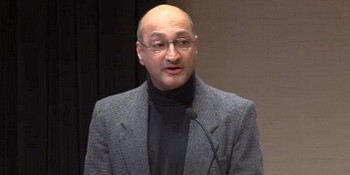Without stepped-up action, the world will be 3–8°C warmer by the end of the century. It’s not too late to avoid catastrophic climate change, but time is running out.
Sivan Kartha is a senior scientist at SEI US, and a member of the Science and Security Board of the Bulletin of the Atomic Scientists.
This post is adapted from prepared remarks given at the Doomsday Clock press conference.

On Thursday we announced that, due to humankind’s continued failure to effectively address climate change or reduce nuclear arsenals, conditions in the world are so threatening that we’ve moved the hands of the Bulletin of the Atomic Scientists’ Doomsday Clock two minutes closer to midnight, to 11:57 p.m.
I’ll let others speak about the threat of nuclear weapons. As a scientist focused on climate policy, I want to try to convey the scale of the climate challenge – and of our efforts so far to address it.
In its latest report, the Intergovernmental Panel on Climate Change (IPCC) said that, if we do not make a concerted effort to avoid greenhouse gas emissions, the Earth will be 3–8°C (5–15°F) warmer by the end of the century.
It is difficult for people to understand why just 3–8°C of warming should bring on a “climate catastrophe”. After all, we often experience much greater temperature swings locally in the course of a single day. However, those local temperature swings – up in one place, down somewhere else – are very different from heating the entire planet and raising its total energy.
It only took 3–8°C of warming to bring the Earth out from the frigid depths of the last ice age some 20,000 years ago. That was enough, in fact, to radically transform the surface of the planet. It was enough to make the Earth hospitable to the emergence of human civilization. And now, that same civilization has progressed to the point where its own technologies could cause the Earth to heat by another 3–8°C. If we let this happen, the Earth’s continued hospitability to human civilization could by no means be taken for granted.
But we don’t have to let this happen.
Indeed, the IPCC concluded unequivocally that we can hold warming below 2°C, and avert a climate catastrophe. We have the technologies to make our homes, our buildings, our industries, and our transportation more energy-efficient, and to shift away from fossil fuels to low-carbon energy sources.
And we can afford to do it. A full-on effort to reduce greenhouse gas pollution is estimated to cost all of 0.06% of annual growth to the global economy (that’s one-16th of a percent). That means that instead of global GDP doubling in, say, 25 years, as it might if we continued to grow along historic trends, it would double in 26 years. Our economies would not be crippled. Our standard of living could continue to improve. And we would get other benefits, such as energy security, reduced air pollution, improved health. Most important, it would protect the hospitable climate on which our civilization depends.
Yet our efforts to address climate change are leagues away from “full-on”. When countries in Rio de Janeiro in 1992 to negotiate an international climate treaty, they did so with the intention of steadily strengthening and expanding the agreement. Instead, the agreement has arguably weakened and shrunk over time.
What had been a system of legally binding targets has devolved to a system of voluntary – and demonstrably inadequate – “pledges”.
What had been envisaged as a financing mechanism to support poor countries trying to deal with climate impacts and develop along a clean energy pathway has barely gotten off the ground, and is sorely underfunded compared to the need.
What had been expected to be a growing circle of countries taking meaningful climate action has instead been marked by key countries – such as the United States, Canada, and Japan – scaling back on commitments.
Indeed, expectations have fallen so far that we find ourselves relieved when even nominal attention is paid to climate change. When the United States recently announced it would cut greenhouse gas emissions by 26% to 28% from 2005 levels by the year 2025, this was lauded as a “historic step” and a “game changer”, even though this was actually back-tracking on the target presented by President Obama five years ago in Copenhagen, when he put forward a 30% cut by 2025. Steps seen as bold in light of today’s extremely daunting political opposition to climate action do not even match the expectations of five years ago, to say nothing of the scientific necessity.
The results are unsurprising. Global greenhouse gas emission rates are now 50% higher than they were in 1990. Emission rates have risen more since 2000 than in the previous three decades combined. Investments have continued to pour into fossil fuel infrastructure at more than $1 trillion per year, plus hundreds of billions of dollars in continued fossil fuel subsidies.
We can turn this around, but time is running out. We need to stop dallying and rise to the challenge.
Design and development by Soapbox.
